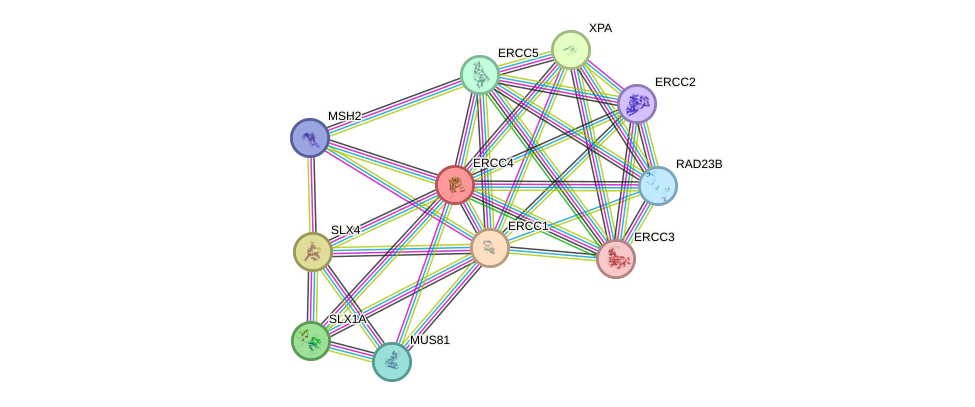GenAge entry for ERCC4 (Homo sapiens)
Gene name (HAGRID: 261)
- HGNC symbol
- ERCC4
- Aliases
- RAD1; FANCQ; XPF
- Common name
- excision repair cross-complementation group 4
Potential relevance to the human ageing process
- Main reason for selection
- Entry selected based on evidence linking the gene product to a pathway or mechanism linked to ageing
- Description
ERCC4, together with ERCC1, is involved in the repair of DNA damage. One patient with a severe mutation in ERCC4 displayed progeroid symptoms. ERCC4-ERCC1-deficient mice show developmental retardation, growth arrest after two weeks and death at four weeks. They also have increased cell death and reduced GH1 and IGF1 signalling as well as some signs of premature ageing [1855]. Mutations in ERCC4 have also been associated with xeroderma pigmentosum [1891]. In worms, XPF-1 (an ortholog of ERCC4) mutants do not display a decreased lifespan. Moreover, XPF-1 deficiency further increases lifespan of daf-2 long-lived mutants [3645]. Although it is possible that ERCC4 plays some role in human ageing, with only patient exhibiting progeroid symptoms further studies are necessary to establish the role of this genes in human ageing.
Cytogenetic information
- Cytogenetic band
- 16p13.12
- Location
- 13,920,157 bp to 13,952,348 bp
- Orientation
- Plus strand
Protein information
- Gene Ontology
-
Process: GO:0000712; resolution of meiotic recombination intermediates
GO:0000722; telomere maintenance via recombination
GO:0000723; telomere maintenance
GO:0000724; double-strand break repair via homologous recombination
GO:0006281; DNA repair
GO:0006283; transcription-coupled nucleotide-excision repair
GO:0006289; nucleotide-excision repair
GO:0006293; nucleotide-excision repair, preincision complex stabilization
GO:0006295; nucleotide-excision repair, DNA incision, 3'-to lesion
GO:0006296; nucleotide-excision repair, DNA incision, 5'-to lesion
GO:0006303; double-strand break repair via nonhomologous end joining
And 13 more GO terms Cellular component: GO:0000109; nucleotide-excision repair complex
GO:0000110; nucleotide-excision repair factor 1 complex
GO:0000781; chromosome, telomeric region
GO:0000784; nuclear chromosome, telomeric region
GO:0005634; nucleus
GO:0005654; nucleoplasm
GO:0005669; transcription factor TFIID complex
GO:0070522; ERCC4-ERCC1 complex
Show all GO termsFunction: GO:0000014; single-stranded DNA endodeoxyribonuclease activity
GO:0001094; TFIID-class transcription factor binding
GO:0003684; damaged DNA binding
GO:0003697; single-stranded DNA binding
GO:0004520; endodeoxyribonuclease activity
GO:0005515; protein binding
GO:0008022; protein C-terminus binding
GO:0010521; telomerase inhibitor activity
GO:0047485; protein N-terminus binding
GO:1990599; 3' overhang single-stranded DNA endodeoxyribonuclease activity
Protein interactions and network
Retrieve sequences for ERCC4
Homologs in model organisms
- Caenorhabditis elegans
- C47D12.8
- Danio rerio
- ercc4
- Drosophila melanogaster
- mei-9
- Mus musculus
- Ercc4
- Rattus norvegicus
- LOC688631
- Saccharomyces cerevisiae
- RAD1
- Schizosaccharomyces pombe
- rad16
In other databases
- GenAge model organism genes
- A homolog of this gene for Mus musculus is present as Ercc4
- LongevityMap
- This gene is present as ERCC4

